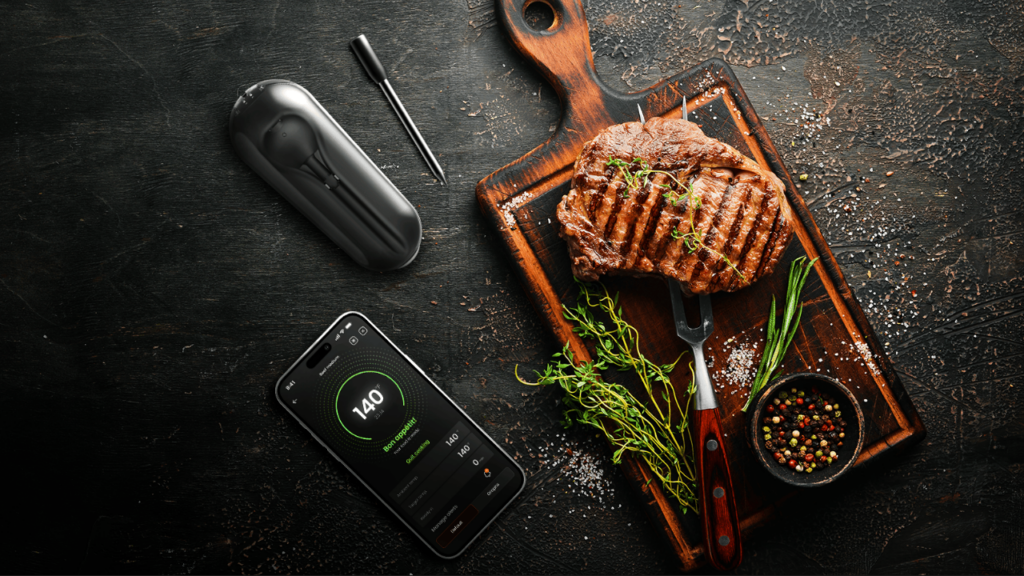Korean barbecue, renowned for its flavorful meats, communal dining experience, and lively atmosphere, has captured the hearts and palates of food enthusiasts worldwide. Whether you’re a seasoned grill master or a novice cook, mastering the art of Korean barbecue, along with its iconic dish, bulgogi, is sure to elevate your culinary repertoire. In this comprehensive guide, we’ll delve into everything you need to know to host a mouthwatering Korean barbecue feast that will leave your guests craving for more, and how you can make it easier using our Meat°it 3.
Understanding Korean Barbecue
Korean barbecue, or “gogi-gui” in Korean, refers to the Korean method of grilling meat, typically beef, pork, or chicken, on tabletop grills. For Korean barbecue, it’s all about its marinades, which are often savory, sweet, and packed with umami flavor. The meat is thinly sliced and grilled to perfection, then enjoyed with an array of accompanying side dishes, known as “banchan,” and wrapped in lettuce leaves with rice and condiments.
The Star of the Show: Bulgogi
Bulgogi, a classic Korean barbecue dish, features thinly sliced beef marinated in a blend of soy sauce, sesame oil, sugar, garlic, and other seasonings. The name “bulgogi” translates to “fire meat,” reflecting the traditional method of grilling the marinated beef over an open flame. Bulgogi is prized for its tender texture and complex flavor profile, making it a beloved favorite among Korean barbecue enthusiasts. You can also keep the steak whole, just like mentioned before, it’s all about the marinade.
Korean Side Dishes for Bulgogi
No Korean barbecue feast would be complete without an assortment of banchan to complement the main dishes. Here are some traditional Korean side dishes that pair perfectly with bulgogi:
- Kimchi: Perhaps the most iconic Korean side dish, kimchi is made from fermented vegetables, typically cabbage or radishes, seasoned with chili pepper, garlic, ginger, and other spices. Its tangy, spicy flavor adds a vibrant kick to any meal, including bulgogi.
- Pickled Vegetables: In addition to kimchi, Korean cuisine features a variety of pickled vegetables, such as cucumbers, radishes, and carrots. These refreshing and crunchy side dishes provide a contrast to the rich flavors of bulgogi and help cleanse the palate between bites.
- Ssamjang: A savory, spicy paste made from fermented soybeans, red chili pepper paste, sesame oil, garlic, and other ingredients, ssamjang is often used as a dipping sauce for grilled meats in Korean barbecue. Its bold, umami-rich flavor enhances the taste of bulgogi and adds depth to each bite.
- Bean Sprout Salad (Kongnamul Muchim): Light and refreshing, bean sprout salad is made from blanched bean sprouts tossed with sesame oil, soy sauce, garlic, and green onions. Its crisp texture and delicate flavor provide a refreshing contrast to the richness of bulgogi.
- Steamed Rice: While not technically a side dish, steamed rice serves as the perfect accompaniment to bulgogi, helping to soak up the flavorful juices and balance out the richness of the meat.
Exploring Other Korean Meat Dishes
In addition to bulgogi, Korean cuisine offers a diverse array of meat dishes that are perfect for grilling and sharing with friends and family. Here are a few other Korean meat dishes to consider adding to your Korean barbecue feast:
- Galbi: Also known as Korean-style short ribs, galbi features beef or pork ribs marinated in a sweet and savory sauce before being grilled to perfection. The marinade typically includes soy sauce, sugar, garlic, sesame oil, and fruit juice, giving the meat a caramelized crust and tender interior.
- Dak Galbi: Dak galbi, or spicy stir-fried chicken, is a popular Korean dish made with boneless chicken pieces marinated in a spicy chili sauce, then stir-fried with vegetables such as cabbage, carrots, and onions. The dish is often served on a sizzling hot plate and enjoyed with steamed rice and lettuce leaves for wrapping.
- Samgyeopsal: Samgyeopsal, which translates to “three-layered flesh,” refers to thick slices of pork belly that are grilled until crispy and golden brown. The meat is typically served with garlic cloves, ssamjang, and fresh lettuce leaves for wrapping, allowing diners to create their own delicious bites.
- Bulgogi Jeon: Bulgogi jeon is a variation of bulgogi that is transformed into a savory pancake. Thin slices of marinated beef are mixed with beaten eggs and flour, then pan-fried until golden and crispy. Bulgogi jeon is perfect for sharing as an appetizer or main dish at your Korean barbecue feast.

Utilizing the Meat°it 3 for Korean Barbecue
For an added layer of precision and convenience in your Korean barbecue cooking, consider incorporating the Meat°it 3 wireless meat thermometer into your grilling arsenal. With its advanced technology and user-friendly design, the Meat°it 3 allows you to monitor the internal temperature of your meat with ease, ensuring that every slice of your steak is cooked to perfection.
Simply insert the probe of the Meat°it 3 into the thickest part of the meat before grilling, and connect it to your smartphone via Bluetooth. The accompanying app provides real-time temperature updates, allowing you to monitor the progress of your steak from anywhere in your home. With customizable temperature alerts, you can rest assured that your meat will reach the ideal doneness without the risk of overcooking.
Setting the Stage for Success
Hosting a memorable Korean barbecue feast begins with careful preparation and attention to detail. Start by selecting high-quality cuts of meat, such as ribeye or sirloin for bulgogi, and marinate them for at least a few hours, or preferably overnight, to allow the flavors to meld and penetrate the meat. While beef is the most common choice for Korean barbecue, don’t hesitate to experiment with pork, chicken, or even seafood for a diverse spread.
Mastering the Grill
When it comes to grilling Korean barbecue, achieving the perfect balance of caramelization and tenderness is key. Preheat your grill to medium-high heat and ensure it’s well-oiled to prevent sticking. Place the marinated meat on the grill in a single layer, allowing it to cook for a few minutes on each side until caramelized and cooked through. Keep a close eye on the meat to prevent overcooking, and adjust the heat as needed to maintain an even cooking temperature.
Building Flavorful Bites
Once the meat is grilled to perfection, it’s time to assemble your Korean barbecue feast. Arrange the grilled meat on a platter alongside an assortment of fresh lettuce leaves, steamed rice, and an array of banchan, such as kimchi, pickled vegetables, ssamjang, and bean sprout salad. Encourage your guests to customize their bites by wrapping the grilled meat and banchan in lettuce leaves, adding a dollop of rice and a drizzle of sauce for an explosion of flavor in every bite.
Creating an Authentic Experience
Beyond the delicious food, creating an authentic Korean barbecue experience involves fostering a sense of camaraderie and connection among your guests. Encourage lively conversation and laughter as everyone gathers around the grill, taking turns cooking and sharing bites of succulent meat and flavorful banchan. Embrace the communal spirit of Korean barbecue, where the act of cooking and dining together becomes a celebration of friendship and good food.
Conclusion
In conclusion, mastering the art of Korean barbecue, along with its signature dish, bulgogi, is a rewarding endeavor that promises to delight your taste buds and impress your guests. By understanding the fundamentals of Korean barbecue, selecting quality ingredients, and mastering the grill, you can host a mouthwatering feast that captures the essence of this beloved culinary tradition. So fire up the grill, gather your friends and family, and embark on a culinary journey that celebrates the rich flavors and communal spirit of Korean barbecue. Make it easier using our Meat°it 3, just like Tasting Tables that has already talked about making dinner parties easier using our wirelesss digital thermometer The Meat°it 3 and more. Bon appétit!

